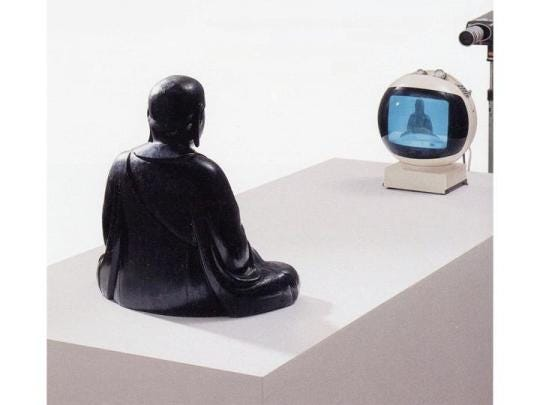created, $=dv.current().file.ctime & modified, =this.modified
NOTE
Further reading after watching doc “Nam June Paik: Moon Is The Oldest Tv”
While video art is still considered “difficult” in some quarters, Paik always tries to make it accessible, combining high entertainment with meaningful symbolic content. Even though this “media art” is now in its fourth decade, some viewers, on the one hand, do not accept it as genuine art because it incorporates electronic components; on the other hand, some observers find it tedious, because often extreme slow-motion sequences do not permit the immediate overall impression that comes with looking at traditional painting, sculpture, or even “environment” works. What usually goes together with these criticisms is the equation of video art with watching a videotape, which only differs from ordinary television programming in the distinctive aesthetics brought to the latter. Precisely because Paik comes from the field of music he understands these objections and obstacles and has been overcoming them effectively for years.
TV Buddha (197a). Here, a Buddha sculpture contemplates its own image on a television screen -probably the most beautiful example of a format that is technically quite simple, but makes a very pointed statement.

Silence - John Cage - On the Work of Nam June Paik
In the course of my studies of Indian philosophy, I had become aware of the nine permanent emotions of aesthetic tradition. The rasas. The four black: sorrow, fear, anger, disgust. The four white: the heroic, the wondrous, mirth, and the erotic. Finally, the one without color, in the center, toward which any work of art should conduce, tranquility. The Etude for Pianoforte was definitely black, a mixing of sorrow, anger, and fear, and these three separate from tranquillity.
Cage wrote about the associated transformation of the human mind: “Your receiver is your mind.’,
Klavier Integral “I press a key, the key moves the hammer, and that moves whatever is stuck on to or is hanging from it; for example, it makes an old shoe dangling over a lid bob up and down.
- I press a key, and it presses on a squeak-bag under- neath it; or an electric switch: the switches are of three kinds, like single buttons, toggle, and double switches, examples:
- If I press C sharp, a transistor radio is switched on; it goes off as soon as I release the C sharp.
- If I press F, an electric motor screwed to the sound- board (l) starts to rumble; it stops again when the F is pressed for a second time.
- If I press the C, a fan heater starts to blow warm air at my legs, the knob that switches it off again is hidden under the A.
As well as the things that have been mentioned, several transistor radios, one or more film projectors, a siren (and other things?) are operated in this way. One key switches off all the lighting in the room (and on again, provided you can find the thing in the dark). Otherwise, on these two pianos you can see, move, use: a doll’s head, a hand siren, a cow’s horn, a plume, barbed wire, a spoon, a tower of pfennig pieces piled on top of each other, all kinds oftoys, photographs, a brassiere, an accordion, an aphrodisiac tin, a pick-up arm from a record player, a padlock, a loose key, lever, etc., etc.”